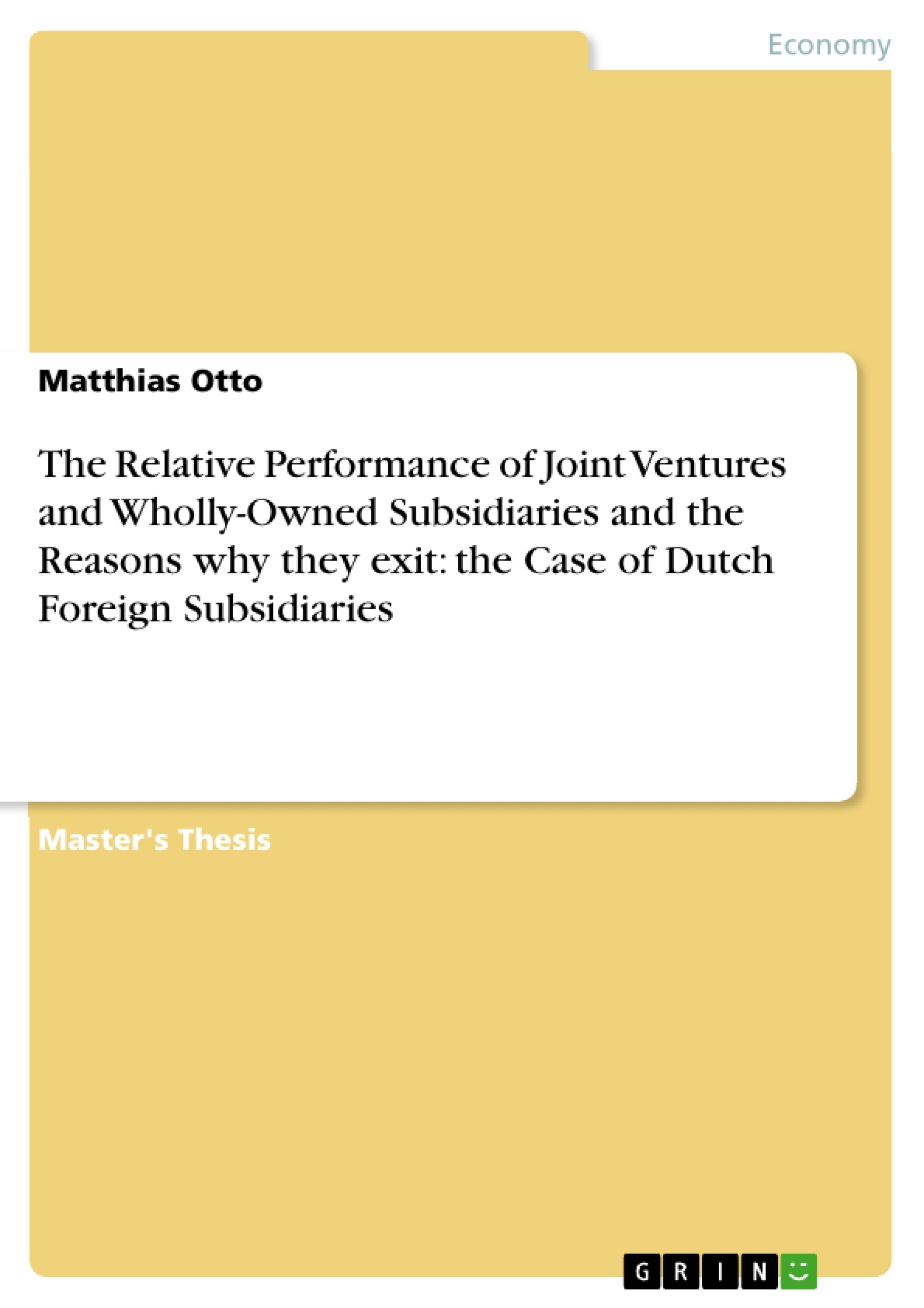Using data on more than 200 foreign entries made by Dutch MNEs between 1995 and 2003, this study examines the relative performance of jointly-owned and wholly-owned affiliates and sheds light on the underlying reasons why these two types of affiliates exit. By employing performance measures such as average longevity and exit rate, and by differentiating between exits through liquidations and those through sell-offs, I find that there are no essential performance differences between WOSs and JVs, which is in line with the results of prior scholarship (e.g. Dang, 1977; Chowdhury, 1992; Chan, 1995; Mata & Portugal, 2000; Pangarkar & Lim; 2003; Delios & Beamish, 2004). Furthermore, the findings reveal that both WOSs and JVs mainly exit voluntarily. The most prevalent reason for WOS exit is strategic restructuring, whereas the most common reason for JV exit is fierce competition in the host market. Finally, I discover supporting evidence for the proposition that MNE parents are more likely to buy out local partners from JVs over which they have majority ownership than from JVs over which they have minority ownership.
Inhaltsverzeichnis (Table of Contents)
- 1. Introduction
- 2. Literature Review
- 2.1 Introduction
- 2.2 Advantages and Disadvantages of WOSS and JVs
- 2.2.1 Advantages of WOSs
- 2.2.2 Disadvantages of WOSs
- 2.2.3 Advantages of JVs
- 2.2.4 Disadvantages of JVs
- 2.3 Theoretical Arguments and Empirical Findings concerning WOS and JV Performance
- 2.3.1 Introduction
- 2.3.2 JVs outperform WOSs
- 2.3.3 WOSs outperform JVs
- 2.3.4 WOSs and JVs perform equally well
- 2.3.5 Summary
- 2.4 Reasons for the Exit of Foreign Subsidiaries
- 2.4.1 Introduction
- 2.4.2 Forced Exits
- 2.4.3 Voluntary Exits
- 2.4.4 Summary
- 3. Propositions
- 3.1 Introduction
- 3.2 Average Longevity and Exit Rate
- 3.3 Exits through Sell-offs and Exits through Liquidations
- 3.4 Reasons for Exits
- 3.5 Changes in Ownership Structure
- 4. Methodology
- 4.1 Introduction
- 4.2 Original Sample
- 4.3 Data Collection and Final Sample
- 4.4 Performance Measures used to test Propositions 1a through 2b
- 4.5 Testing Propositions 3a, 3b, and 4
- 5. Results
- 5.1 Introduction
- 5.2 Average Longevity and Exit Rate
- 5.3 Exits through Sell-offs and Exits through Liquidations
- 5.4 Reasons for Exits
- 5.5 Changes in Ownership Structure
Zielsetzung und Themenschwerpunkte (Objectives and Key Themes)
This thesis aims to analyze the relative performance of joint ventures (JVs) and wholly-owned subsidiaries (WOSs) and investigate the reasons behind their exit from foreign markets, focusing specifically on Dutch foreign subsidiaries. The study examines existing literature on the topic, develops propositions, and tests these propositions using empirical data.
- Relative performance of JVs and WOSs
- Reasons for exit of foreign subsidiaries (forced vs. voluntary)
- Methods of exit (sell-offs vs. liquidations)
- Impact of ownership structure changes
- Empirical analysis of Dutch foreign subsidiaries
Zusammenfassung der Kapitel (Chapter Summaries)
Chapter 1 introduces the research topic and outlines the thesis's structure. Chapter 2 reviews existing literature on the advantages and disadvantages of JVs and WOSs, exploring theoretical arguments and empirical findings related to their relative performance and reasons for exit. Chapter 3 presents the propositions that will be tested in the study. Chapter 4 details the methodology used, including data collection and sample selection. Chapter 5 presents the results of the empirical analysis, examining average longevity, exit rates, exit methods, and reasons for exit.
Schlüsselwörter (Keywords)
Joint ventures, wholly-owned subsidiaries, foreign direct investment, performance, exit, Dutch multinational enterprises, ownership structure, sell-offs, liquidations.
- Quote paper
- Matthias Otto (Author), 2009, The Relative Performance of Joint Ventures and Wholly-Owned Subsidiaries and the Reasons why they exit: the Case of Dutch Foreign Subsidiaries, Munich, GRIN Verlag, https://www.grin.com/document/186730



